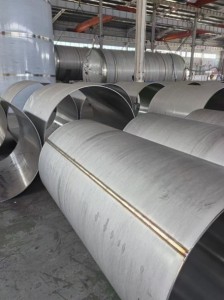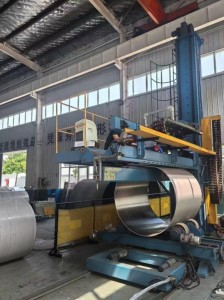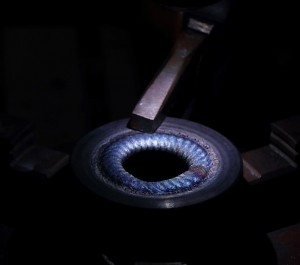Welding and cladding are two core technologies that are widely used in a number of industrial fields. Although they both involve the heat treatment and processing of metal materials, there are significant differences in the purpose of their application, technical principles, and final results. As manufacturing technology continues to evolve, the correct distinction and application of these two processes is critical to the improvement of production efficiency and product performance.
Welding: the core technology for joining metals
Welding is a technique for permanently joining two or more metal workpieces by localized heating or pressure. During the welding process, the weld metal and the base material melt simultaneously, forming a continuous weld seam to achieve a physical connection between the materials. Welding is widely used in the automotive, construction, aerospace, marine, and pipeline industries, primarily for the splicing and assembling of structural components.

The key purpose of welding is to ensure structural integrity and strength. For example, in the fabrication of bridges or large equipment, welding provides a strong, reliable connection that ensures that the metal structure retains its strength and safety despite high loads or harsh environments.

Common welding processes include:
• Arc welding (Arc Welding): An electric arc is generated by an electric current, which locally melts the welding consumables and the workpiece to form a joint. Suitable for welding thick plates and large-sized structures.
• Gas Shielded Welding (MIG/TIG Welding): Oxygen in the air is isolated by shielding gas to avoid oxidation during the welding process. Suitable for fine welding and thin plate welding, widely used in stainless steel and aluminum alloy welding.
• Plasma Welding (Plasma Welding): Utilizes a high energy plasma arc for high precision welding, suitable for scenarios requiring high weld quality, such as the welding of stainless steel or titanium alloys.
Cladding: Surface Enhancement and Repair Technology
Cladding is a technique for modifying the surface properties of a workpiece by melting and depositing a special alloy onto the surface of a substrate. Unlike welding, cladding is not used to join materials together, but is designed to enhance the wear, corrosion or high temperature resistance of the substrate surface. Cladding is widely used in the petroleum, chemical, mining, metallurgical and other industries to strengthen and repair equipment surfaces.

Typical application scenarios for cladding include:
• Wear-resistant parts: Coating the surface of highly abrasive workpieces such as mining machinery or pump shafts with cemented carbide materials to significantly improve their wear resistance and extend their service life.
• Corrosion-resistant coatings: Enhance the corrosion resistance of equipment in acidic or marine environments by cladding corrosion-resistant alloys such as nickel-based alloys or stainless steel.
• High-temperature components: Turbine blades or boiler tubes can be fusion clad with high-temperature-resistant materials to improve their stability in extreme high-temperature environments.
Cladding processes include:
• Laser cladding: Using a laser as a heat source, an alloy powder is rapidly melted and deposited on the surface of the substrate. The advantages of laser cladding are a small heat affected zone and precise coating, which makes it suitable for high precision surface treatment.
• Plasma cladding: The alloy powder is melted by plasma arc and deposited on the surface of the substrate, which is suitable for large surface repair or strengthening.
• Arc cladding: cladding is carried out by arc heat source, suitable for cladding of thick layer coatings, commonly used in heavy industry for repairing large equipment.
Key differences between welding and cladding:
1.Purpose of Application:
• Welding: designed to permanently join two or more materials together to form a complete structure. It is mainly used to carry and connect structural components, ensuring mechanical strength and structural stability between metal parts.
• Cladding: Focuses on improving the properties of the surface of the workpiece rather than the connection between materials. By adding a layer of special alloy to the surface of the base material, it enhances wear resistance, corrosion resistance and resistance to high temperature, and extends the service life of the workpiece.
2.Process:
• Welding: By melting the weld metal and part of the base material, they are combined to form a strong weld. The welding process is usually accompanied by high temperatures, glare and welding fumes with a large heat affected zone.
• Cladding: Melting and depositing a layer of a specific material on the surface of the workpiece. The base material usually produces only a small melting on the surface, and the mechanical properties of the base material itself remain unchanged. The heat-affected zone of cladding is small, especially in laser cladding, where the energy concentration is extremely high and there is little material waste.
3.Final effect:
• Welding: The end result is a strong, permanent joint that ensures a tight fit between the different parts to form a complete structure or assembly.
• Cladding: Instead of a structural joint, a functional surface coating is formed, giving the workpiece new properties such as higher hardness, wear resistance or corrosion protection.
As the manufacturing industry continues to move towards high quality and intelligence, welding and cladding technologies will continue to play an important role in improving the strength of material connections and surface properties. Welding technology provides a guarantee for the safety and strength of large metal structures, while cladding technology brings a more cost-effective solution for optimizing and repairing the surface properties of critical equipment.
Get world-class plasma cladding services from Shanghaiduomu!
At Shanghaiduomu, we are more than happy to help you with any plasma cladding service or application you need. With over 10 years of experience in plasma solutions, you can rely on us for whatever plasma application you are looking for!
In addition to our expertise in plasma cladding, we are also China's top supplier of cladding accessories and equipment, welding and more!
Our plasma cladding solutions will be the last thing you need! Contact us today for a free estimate on any of the services you need! Get world-class customer service and assistance from our experienced team of agents and operators!
Post time: Sep-06-2024